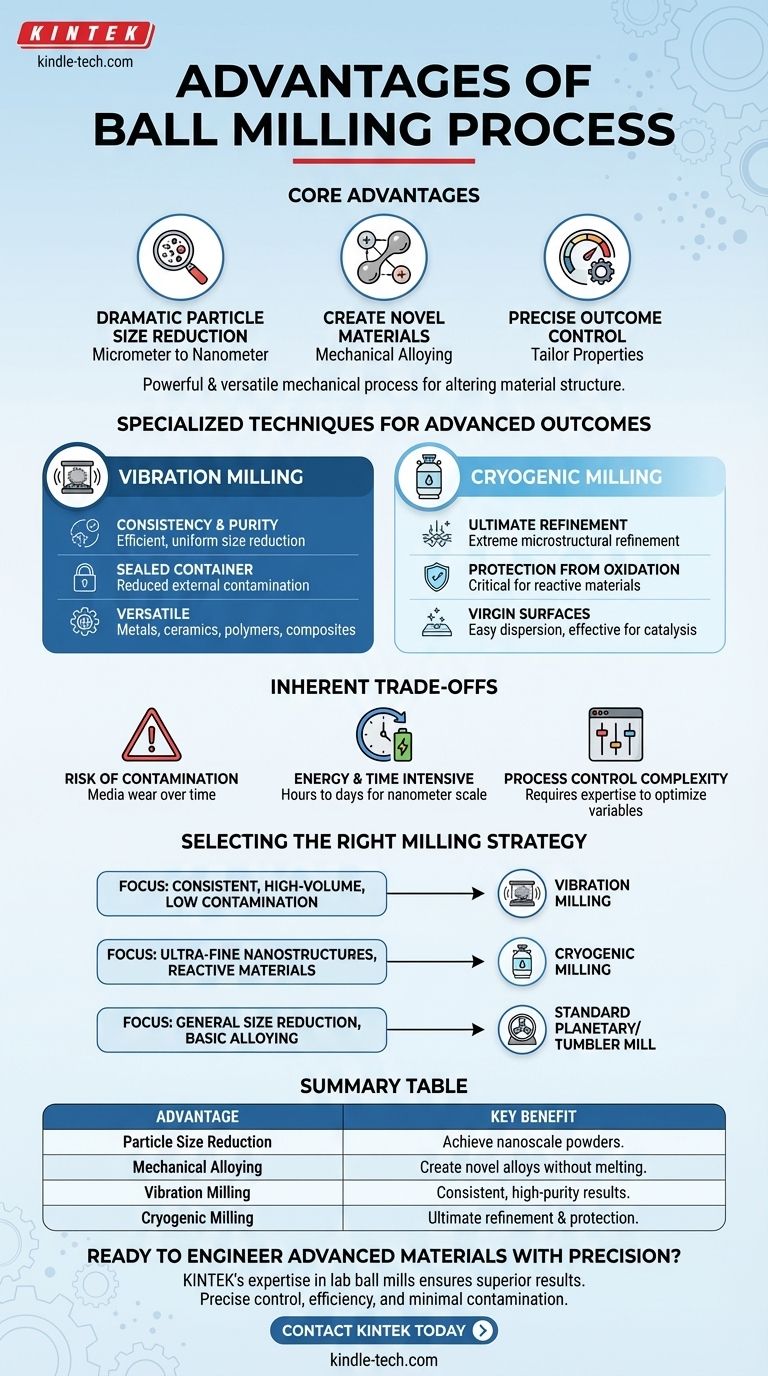At its core, ball milling is a powerful and versatile mechanical process for altering the structure of materials. Its main advantages are the ability to dramatically reduce particle size down to the nanometer scale, create novel materials through mechanical alloying, and precisely control outcomes by modifying the milling environment. The process works by using mechanical energy from grinding media (the balls) to induce structural and chemical changes in a sample.
The primary advantage of ball milling lies not in a single benefit, but in its adaptability. By controlling key parameters like temperature and motion, you can tailor the process to achieve specific, advanced material properties, from simple particle size reduction to the creation of highly refined, contamination-free nanostructures.

The Fundamental Advantage: Mechanical Energy as a Tool
Ball milling uses physical force to fundamentally change materials. This direct application of energy is the source of its core benefits.
Particle Size Reduction
The most common application is grinding coarse materials into fine powders. This process, known as comminution, is highly effective and can reduce particles from the micrometer to the nanometer scale.
Material Alloying and Phase Transformation
Ball milling can be used to create alloys from elemental powders without melting them. The repeated fracturing and cold-welding of particles forces atoms to mix, forming new solid-solution alloys and intermetallic compounds.
Specialized Techniques for Advanced Outcomes
While standard ball milling is effective, specialized variations unlock unique advantages for demanding applications.
Vibration Milling: For Consistency and Purity
Vibration milling uses a high-frequency vibrating chamber instead of a rotating drum. This modification leads to several key benefits.
It offers highly efficient and uniform particle size reduction, ensuring consistency across production batches.
The process typically occurs in a sealed, closed container, which significantly reduces the risk of contamination from external sources like the atmosphere.
This technique is also highly versatile, capable of processing a wide range of materials including metals, ceramics, polymers, and composites.
Cryogenic Milling: For Ultimate Refinement and Protection
Cryogenic milling (or cryomilling) is performed at extremely low temperatures, typically using liquid argon or nitrogen (below -150°C). This environment prevents heat-related material changes.
The low temperature suppresses material recovery and recrystallization, which allows for extreme microstructural refinement and the creation of true nanostructures.
Cryomilling provides exceptional protection from oxidation and nitridation, which is critical for reactive materials. Using liquid argon instead of nitrogen can further avoid unwanted nitrogen contamination.
This process creates nanoparticles with "virgin" surfaces that are exceptionally clean, making them easier to disperse in solvents and highly effective for applications like catalysis.
Understanding the Inherent Trade-offs
No process is without its limitations. Objectively evaluating the trade-offs is critical for making an informed decision.
Risk of Contamination
While some techniques reduce contamination, it is never zero. The grinding media (balls) and the vial itself can wear down over time, introducing small amounts of impurities into the final product.
Energy and Time Consumption
Achieving nanometer-scale particles or complete alloying is an energy-intensive process. Milling times can range from hours to days, which has significant implications for energy costs and throughput.
Process Control Complexity
The effectiveness of ball milling depends on precise control over variables like milling speed, time, ball-to-powder ratio, and temperature. Optimizing these parameters for a specific outcome requires expertise and careful experimentation.
Selecting the Right Milling Strategy
To make the best choice, align the technique's strengths with your primary goal.
- If your primary focus is consistent, high-volume production with low external contamination: Vibration milling is an excellent choice due to its efficiency and sealed environment.
- If your primary focus is creating ultra-fine nanostructures or processing highly reactive materials: Cryogenic milling offers unparalleled refinement and protection from oxidation.
- If your primary focus is general-purpose size reduction or basic mechanical alloying: A standard planetary or tumbler ball mill provides a cost-effective and proven solution.
Ultimately, choosing the right ball milling process empowers you to precisely engineer materials from the ground up.
Summary Table:
| Advantage | Key Benefit |
|---|---|
| Particle Size Reduction | Achieve nanoscale powders from coarse materials. |
| Mechanical Alloying | Create novel alloys without melting. |
| Vibration Milling | Consistent, high-purity results with low contamination. |
| Cryogenic Milling | Ultimate refinement and protection for reactive materials. |
Ready to engineer advanced materials with precision?
Whether your lab requires standard particle size reduction or specialized cryomilling for nanostructures, KINTEK's expertise in lab ball mills and consumables ensures you achieve superior results. Our equipment is designed for precise control, efficiency, and minimal contamination.
Contact KINTEK today to discuss your specific material processing needs and discover the ideal milling solution for your laboratory.
Visual Guide

Related Products
- High Energy Planetary Ball Mill Machine for Laboratory Horizontal Tank Type
- High Energy Planetary Ball Mill Milling Machine for Laboratory
- High-Energy Omnidirectional Planetary Ball Mill Milling Machine for Laboratory
- High-Energy Omnidirectional Planetary Ball Mill Machine for Laboratory
- High Energy Planetary Ball Mill Milling Machine for Laboratory
People Also Ask
- What is the capacity of a ball mill? Optimize Your Grinding Process for Maximum Efficiency
- What are the disadvantages of a ball mill? Key Limitations for Your Grinding Process
- What are the characteristics of a ball mill? Achieve Ultra-Fine Grinding for Your Materials
- What is the working capacity of a ball mill? Optimize Volume, Speed, and Grinding Media for Maximum Output
- What is the difference between a ball mill and an attritor? Choose the Right Mill for Your Particle Size Goals



















